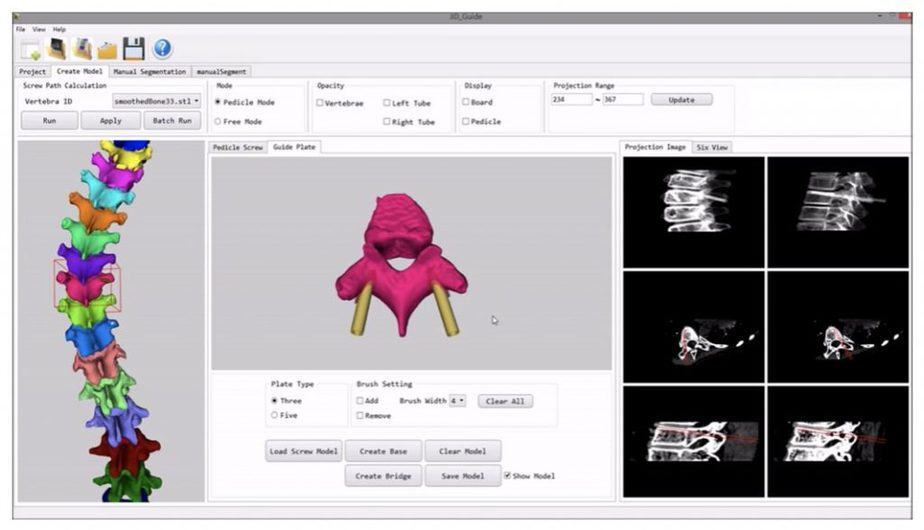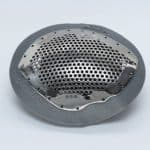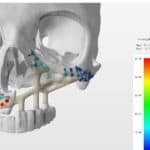Want to write a piece for 3DHEALS Expert Corner? Email us: info@3dheals.com
The vertebrae are 26 individual, interlocking bones that form the spinal column and contains three main functional components: the vertebral body for load-bearing, the vertebral arch to protect the spinal cord, and transverse processes for ligament attachment [1]. The spinal column consists of cervical, thoracic, and lumbar vertebrae in addition to sacral and coccyx region. Vertebrae are interconnected by facet joints that allow mobility in the spine. Intervertebral discs separate the individual bones providing additional weight-bearing support. When people are overweight, getting older, injury, genetic defect, and high-stress loading on the spine vertebrae, Osteoarthritis occurs [2]. In addition, many diseases such as degenerative disk disease, spondylolisthesis, spinal stenosis, scoliosis, fractured vertebra, infection, herniated and the tumor will need spinal fusion surgery to correct and treat. The basic idea of spinal fusion is to fuse together two or more vertebrae so that they fuse into a single, solid bone. The procedure involves roughening the bone between two adjacent vertebrae and then placing bone graft between them. And then rods and screws are then placed to create an “internal cast” that support the vertebrae, holding it together until the fusion, or bony regrowth can occur [3].

In 1900, Dr. Russel A. Hibbs had developed his own novel technique of spinal arthrodesis that drew from operations previously performed on the knee. He published this method after a successful operation on a nine-year-old boy with tuberculosis spinal deformity which was a monumental stride in the surgical correction of spinal deformities. Since then, abundant research and clinical practices have been performed and kept the improvement [4]. During the mid-20th century, many surgeons focused their careers on the development of novel bracing and surgical techniques for the management of spinal deformity. Effective flexible rods and wires threaded through each vertebral level were utilized to achieve a better outcome and even the corrective brace remove after surgery. Roy-Camille et al reported the use of a screw-plate device for the treatment of spinal fractures, the era of the pedicle screw began and had been utilized till nowadays [5]. Since then, medical image technology, such as CT and MRI, started to play a critical role in understanding the human anatomic structure. In recent years, medical imaging and surgical hardware devices have made significant progress [6]. Besides, in order to improve the accuracy of implant implantation and shorten the operation time, the intraoperative navigation system has been gradually used in clinical pedicle screw fixation in this decade. However, the most important procedure before the operation is spinal surgery planning no matter with/without a navigation system. A high accuracy planning system could help the surgeon to place pedicle screws precisely and consider the screw stability is dramatically need for a current spinal operation.

China Medical University Hospital (CMUH), the pioneer in medical applications of 3D printing in Taiwan, collaborated with Georgia Institute of Technology to establish the first 3D printing institute to hold the entire chain from the development of fundamental research to clinical applications and leading the industry in Taiwan. The 3D Printing Medical Research Center (3DP MRC) provides the complete medical 3D printing service from medical image simulation to design analysis and manufacturing of customized medical devices by the 3D printing. These include allowing multiple simulations to optimize preoperative surgical planning, reducing medical costs, minimizing wounds, shortening recovery time, significantly decreasing surgery duration, and improving the safety of surgery.

In order to provide a better and more accurate surgical planning, CMUH 3DP MRC develops a 3D modeling and manipulation system for precision spinal fusion surgery, which we called Smart Spine Surgery System. This system is capable of 3D spine anatomical modeling, screw trajectory exploring, bone quality assessment, and pre- and postoperative evaluation and prediction via simulated fluoroscopy which assists the surgeon in selecting the desired screw trajectory path without changing the surgical rules and additional training. [Figure 1-4] Artificial Intelligent technology is applied in this system to construct the spine 3D CAD model, furthermore, segment the selected vertebrae, and provide the optimal screw trajectory suggestion. In addition, the team established a novel CT image synthesis methodology to correct the spectral dependence of the CT numbers by normalizing the CT numbers to the same spectrum condition. This methodology could help to provide an accurate quantitative evaluation of bone density and implant bio-mechanical properties even though the CT images were X-ray spectrum dependence in multi-centers or multi-modalities research. We believe an excellent surgery planning tool and the intelligent 3D printed templates design software will help surgeons have better surgery performance and better clinical outcome for patients.

[1] Gregory D. Cramer, and Susan A. Darby, Clinical Anatomy of the Spine, Spinal Cord, and Ans (Third Edition),Mosby, 2014.
[2] Chang HJ, Lynm C, Glass RM. Osteoarthritis of the Lumbar Spine. JAMA. 2010; 304(1):114.
[3] Tarpada SP, Morris MT, Burton DA., Spinal fusion surgery: A historical perspective. J Orthop. 2016 Nov 9;14(1):134-136. eCollection 2017 Mar. Review.
[4] Miller DJ, Vitale MG, Russell A. Hibbs: pioneer of spinal fusion. Spine. 2015; 40(16):1311–1313.
[5] Kabins MB, Weinstein JN. The History of Vertebral Screw and Pedicle Screw Fixation. Iowa Orthop J. 1991;11:127–136.
[6] Khoshnevisan A, Allahabadi NS. Neuronavigation: principles, clinical applications and potential pitfalls. Iran J Psychiatry. 2012;7(2):97–103.
About the Author:

Dr. YiWen Chen received her M.S. and Ph.D. degrees in Industrial and Manufacturing Engineering (Nanomaterial Group) Florida State University, USA. She joined China Medical University Hospital and funded the 3D Printing Medical Research Center in 2014. She is responsible for leading the team and developing and implementing the 3D printed medical research and clinical application integration. She is also the Associate Professor of Graduate Institute of Biomedical Science at China Medical University since then. Dr. Chen’s research interests focus on to develop and deliver advanced and affordable 3D printed medical care including biomedical devices, implants, and therapeutics for medical applications. Several of her patents and technologies have to tech-transfer to industries. She was awarded the 2017 and 2018 Innovation in Taiwan. She is also a member of the Board of Supervisors of the Additive Manufacturing Association in Taiwan(AMAT) and a board of director of China Medical Derivatives Corporation – Everyoung Biomedical International. She is responsible for providing relevant technical advice and is often invited to serve as lecturers at many international academic conferences. Many achievements of her research team are also recognized by high-impact journals, media, conference scientific publications, and published works. She has published 35 peer-reviewed articles and holds 15 issued/pending patents.
Related Articles:
3D Printed Orthopedic Implants in China and the Challenges in Commercialization
How 3D Printing with Silicones Might Change Medical Science
Taipei Taiwan Event Recap: 2018 – What’s next after the hype?



 May 12, 2019
May 12, 2019 






Comments